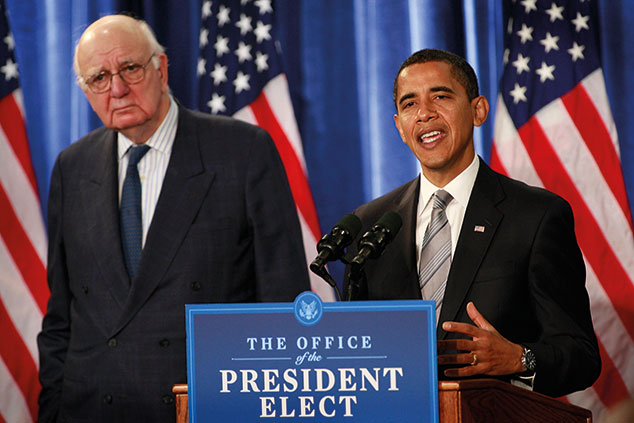
America’s financial regulators are set to ease the Volcker rule. Critics say the decision will undo years of efforts to make banks less risky after the financial crisis. Simon Wilson reports.
What is the Volcker rule?
It is a key part of the post-financial crisis Dodd-Frank regulatory framework in the US that was intended to make banks safer and cut the risk of another crisis of the kind that brought the global economy to its knees in 2008-09. In the aftermath of the crisis, Paul Volcker, the chairman of the Federal Reserve in the 1980s, was a key adviser to President Barack Obama on how to drive economic recovery and mitigate the risk of another meltdown.
His eponymous rule restricts banks from engaging in speculative trading on their own account (“proprietary trading”) rather than on behalf of customers or in the interests of market-making. The rule was originally intended to come into effect as part of the Dodd-Frank post-crisis regulatory reforms of 2010. But after years of hold-ups and legal objections, the rule wasn’t introduced until 2013, and didn’t come fully into effect until July 2015.
Why is it important?
There’s nothing wrong in principle with financial institutions trading on their own account. That’s what hedge funds, among others, do every day. But banks are different: they are licensed by the government and are federally insured. In other words, banks’ ultimate authority and credibility is underwritten by legal and political guarantees. As such, they are answerable to regulators, who have a duty to the public to constantly assess and mitigate risk.
The aim of Volcker, and others, was to restore the distinction between commercial banking (the supply of credit to households and businesses) and investment banking (the issuing and trading of securities and financial derivatives). That separation was enforced by the 1933 Glass-Steagall Act, but had broken down since the act was repealed in 1999. Critics blamed the repeal for the build-up of risk at the very biggest banks, such as Citigroup and Bank of America.
Were the banks happy to comply?
No. Right from the start, banks have complained that the Volcker “rule” – actually a vast set of complicated rules running to 964 pages of regulations and guidance – is ridiculously complex and muddled. The main difficulty is essentially to do with defining what counts as proprietary trading. At the heart of banks’ objections is the rule’s basic presumption that trades of less than 60 days were proprietary unless a bank could show otherwise. From the banks’ perspective, this presumption means they are constantly being required to prove a negative.
Also, the subjective question of intent – whether traders are really making markets for customers or taking a view on the direction of prices for their own benefit – adds another layer of complexity and inhibits traders’ ability to lubricate markets. Famously, Jamie Dimon of JPMorgan Chase claimed that under the Volcker rule traders would need both a psychiatrist and a lawyer sitting beside them before they did anything.
So what changes are being made?
The relevant US regulators (all of which are now run by Donald Trump’s appointees) are planning to turn this on its head. Proprietary trading will still be banned. But the regulators want to make life easier for the banks by scrapping the presumption that short-term trading positions of less than 60 days are proprietary unless proven otherwise. Instead, they want to make all trades allowable unless they breach certain risk and position limits, defined in relation to customer demand.
The regulators’ proposals won’t take effect immediately – each of the five federal regulators must publish their proposals for public comment, and the revised rule is unlikely to take effect until late 2018 or early 2019. But the move is important, not least because it is part of a wider deregulation effort under Trump.
What else is being loosened?
Trump recently signed into law measures that allow thousands of small and medium-size banks to avoid tougher oversight. Last month the US Federal Reserve proposed easing limits on how much the biggest banks can borrow. And the Consumer Financial Protection Bureau has halted new investigations and stopped collecting data from certain banks.
Meanwhile the appointment of a new head of the Federal Deposit Insurance Corporation means each of the main US financial regulatory bodies is now run by a figure committed to cutting regulation. So the crucial news for the biggest banks is that “Team Trump is finally in place”, says Ben McLannahan in the Financial Times. “And now the inter-agency projects can begin” – starting with Volcker 2.0.
Is this a good thing?
Some argue that reforming the Volcker rule isn’t enough and want it scrapped. It is no business of the government to say which assets are too risky, says Norbert Michel in Fortune. He argues that commercial banks take risky bets all the time by lending out federally-insured deposits, and that stopping them from hedging and making securities trades on their own account doesn’t cut risk for banks – it stops them from mitigating it. But other commentators are far more cautious.
What might go wrong?
The White House is showing no inclination to force banks to hold more capital, says Stephen Gandel in The Washington Post. Thus “cumbersome” rules that limit risky behaviour in other ways remain absolutely necessary. As for the recent deregulation of smaller banks (with assets below $250bn), this looks reckless, says Patrick Jenkins in the FT. Institutions of this size were the source of both the savings and loans crisis in the 1980s and the subprime meltdown a decade ago, which was amplified via Wall Street into a global crisis. “Repeating those mistakes so soon is not only financially irresponsible, it is politically incendiary.”